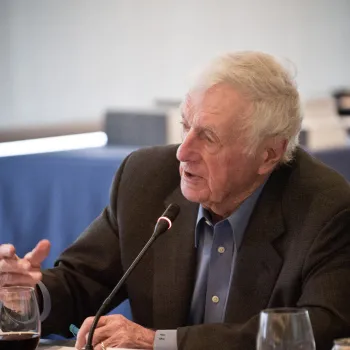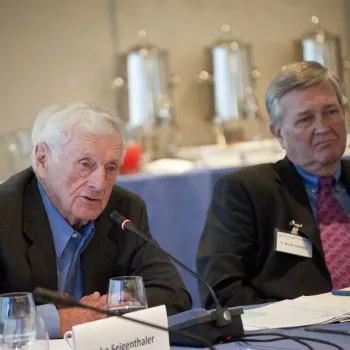Beginning 15 years ago and continuing through last year, noted publisher and First Amendment advocate John Seigenthaler met annually with groups of journalists and federal judges in an effort to help them better understand each other.
The sessions took place in Kansas City, MO, Nashville, TN, Boston, MA, Vermillion, SD, and Washington, D.C., among other locations. And by all accounts, Seigethaler, who died July 11, 2014, made great progress.
"With the passing of John Seigenthaler, the federal Judiciary has lost a cherished friend and partner, who was a champion devoted to the preservation of a vital Third Branch,” said Chief Judge Robert Katzmann. “John’s pioneering Judges and Journalists programs importantly increased media understanding of the courts, benefiting the courts, the media and the public they both serve," said Katzmann, who chairs the Judicial Branch Committee of the Judicial Conference, which has partnered with the First Amendment Center in the Judges & Journalists programs (J&J).
Since their inception, more than 15 J&J programs have been held. Another is scheduled for later this year. The constant in each session was Seigenthaler and his uncanny ability to connect equally well with judges and journalists.
At the conclusion of the 2002 J&J session in Kansas City, Seigenthaler told the participating journalists and judges from the Eighth and Tenth Circuits: “We don’t have to reach any grand conclusions. Two different cultures have come closer together. It’s worth pursuing.”
U.S. District Judge D. Brock Hornby, who chaired the Judicial Branch Committee prior to Katzmann, recalled Seigenthaler’s “undying curiosity about judges’ workways and his desire to help journalists understand their distinctive nature, as well as the converse—to help judges understand the workway needs of journalists.”
A hallmark of the sessions was the fast-paced discussions Seigenthaler led, in which he probed each judge present about coverage of a high-profile matter they had handled. The judges were impressed by his knowledge and preparation, as well as Seigenthaler’s willingness to challenge their perceptions and practices. He was equally probing with journalists, often questioning them about why their articles often identified judges by the President who appointed them, a frequent topic of debate at the J&J programs.
"At every one of these meetings between judges and journalists, John showed his deep respect for the federal judiciary and he celebrated its independence as one of the most important foundations of our democracy,” said veteran legal journalist Tony Mauro, who attended several J&J sessions.
“Judges returned that respect, and for many of them, John personified the best of the news media—aggressive, yes, but not hellbent on tearing down institutions like the judiciary," Mauro said. "These meetings and the role that John played in them went a long way toward improving the sometimes wary relationship between judges, reporters and editors."
While Seigenthaler deftly guided the J&J sessions, judges also recalled the hours they spent, often late into the night, raptly listening to Seigenthaler’s stories, many which have become a part of our nation’s history.
“John epitomized the oft-used expression which describes an individual who has associated with royalty, but retained the common man's touch,” said Bankruptcy Judge Jeffery Hopkins, who attended several J&J sessions as a member of the Judicial Branch Committee.
Hornby recalled Seigenthaler’s “skills as a raconteur, recounting anecdotes from his past, his genuine interest in people, including the judges who learned from him, and his broad perspective derived from the variety of his professional experiences.”
In addition to the many relationships that have been forged between judges and journalists around the country, several other projects trace their origins to the the J&J programs.
One is a website toolbox the Judiciary has developed to help make federal court Internet websites easier to navigate. This idea was first discussed after journalists cited their increased reliance on court websites, yet their frustration in locating certain information. Today the toolbox is in use in more than 90 federal courts across the country.
In 2004, the Administrative Office of the U.S. Courts published the Journalists’ Guide to the Federal Courts, following a J& J session earlier that year at Harvard University. “More and more judges seem open to the idea of perhaps helping journalists understand the work of their court,” Seigenthaler told First Circuit judges and area journalists gathered at that session. The Journalists’ Guide was developed to assist such discussions.
In 2009, the American Bar Association’s launched Media Alerts on Federal Courts of Appeals, a website intended to inform the media and public of key cases in the federal courts of appeals. The announcement of the new site was made at a J&J program at the Newseum in Washington, D.C.
Three years later, the Seigenthaler News Service was established at Middle Tennessee State University to provide journalism students with an opportunity to learn how to cover the courts first-hand. Annually, seven Seigenthaler Fellows are selected to intern at the Tennessean, the daily paper in Nashville where Seigenthaler first served as a reporter in 1954 and later became editor. The program is believed to be the only one of its kind in the country.
In 1999 Seigenthaler spoke at a conference at which participants were asked to suggest ideas for improving public trust and confidence in the courts. “Well, I think any strategy that is taken on must include as a priority improving media understanding of what the system is about. And after that, I don’t have a second priority.”
James Duff, who attended J&J programs both as Director of the Administrative Office of the U.S. Courts and then as Chief Executive Officer of the Newseum, called Seigenthaler “a gift to our country. His pledge of allegiance to the Republic was not a routine recitation nor passive expression of sentiment. For John, it was a call to action. He devoted his life to making certain that liberty and justice for all applied to all. He thereby breathed life into our Constitution,” Duff said in a message to Seigenthaler’s co-workers. “John Seigenthaler was a champion of freedom. We will miss him more than words can describe.”
Subscribe to News Updates
Subscribe to be notified when the news section is updated.



